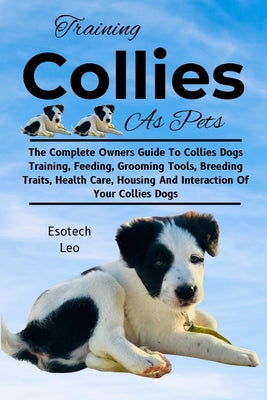
all Products
New Releases
Pets
Training Collies as Pets: The Complete Owners Guide To Collies Dogs Training, Feeding, Grooming Tools, Breeding Traits, Health Care, Housing And
Training Collies as Pets: The Complete Owners Guide To Collies Dogs Training, Feeding, Grooming Tools, Breeding Traits, Health Care, Housing And
Leo, Esotech
Select Format
Regular price
$15.99 USD
Regular price
$11.24 USD
Sale price
$15.99 USD
Unit price
per
Shipping calculated at checkout.

Collies are a beloved and versatile breed, celebrated for their intelligence, loyalty, and striking appearance. Known for their role as herding dogs and their portrayal in popular media, Collies have captured the hearts of families around the world. This introduction provides an in-depth exploration of their breed characteristics, history, and origins.
Overview of the Breed
Collies are medium-to-large-sized dogs that belong to the herding group. They are characterized by their graceful build, keen intelligence, and affectionate nature. The breed comes in two main varieties: Rough Collies, known for their long, luxurious coat, and Smooth Collies, which feature a shorter, dense coat. Both types share the same core temperament and herding instincts but differ in grooming needs.
Key physical traits include:
Size: Typically standing 22-26 inches tall at the shoulder and weighing 50-75 pounds.
Coat Colors: Common colors include sable and white, tricolor (black, white, and tan), blue merle, and white.
Eyes: Expressive almond-shaped eyes, often brown, though blue eyes are seen in merle-coated Collies.
Collies are widely recognized for their intelligent and loyal demeanor. They are naturally protective but rarely aggressive, making them excellent family pets. Their high trainability and adaptability also make them suited for various roles, including therapy dogs, search-and-rescue work, and, of course, their traditional role as herding animals.
History and Origins
The Collie's history is deeply rooted in Scotland and Northern England, where they were originally bred as working dogs for herding sheep and cattle. Their name likely derives from the "colley" sheep they were tasked with tending, though the exact etymology remains debated.
Early Beginnings:
Collies were primarily working dogs, valued for their ability to manage livestock in the rugged, often harsh landscapes of the British Isles. They were bred for endurance, intelligence, and an innate ability to work closely with shepherds. These early Collies were less standardized in appearance but shared the core traits of modern Collies: agility, a strong work ethic, and a sharp mind. The Victorian Era and Breed Popularity:
The Collie gained widespread recognition during the 19th century, largely due to Queen Victoria's fondness for the breed. During her visits to Scotland, she became captivated by their beauty and intelligence, bringing several back to her royal estate. This royal endorsement significantly elevated the Collie's status from a working farm dog to a companion animal for the aristocracy. Breed Standardization:
With their growing popularity, efforts to standardize the breed began. Dog shows in the late 19th century helped refine their appearance and differentiate Rough and Smooth Collies. The focus shifted toward developing the breed's iconic long coat (for Rough Collies) and emphasizing their elegant features. Modern Role and Global Spread:
Collies were introduced to North America and other parts of the world in the late 19th and early 20th centuries. They quickly became household names, thanks in part to literature and media portrayals, most notably in the "Lassie" series. These depictions showcased the breed's intelligence, bravery, and loyalty, solidifying their image as the quintessential family dog. Despite their evolution into companions and show dogs, Collies retain their herding instincts and are still used for this purpose in some areas today. Their versatility and adaptability have allowed them to excel in modern canine activities, including agility, obedience trials, and therapy work.
Collies are not just iconic due to their beauty or media presence but because they embody a rare combination of intelligence, devotion, and versatility. Their rich history as working dogs and companions continues to influence their role in families worldwide.
Overview of the Breed
Collies are medium-to-large-sized dogs that belong to the herding group. They are characterized by their graceful build, keen intelligence, and affectionate nature. The breed comes in two main varieties: Rough Collies, known for their long, luxurious coat, and Smooth Collies, which feature a shorter, dense coat. Both types share the same core temperament and herding instincts but differ in grooming needs.
Key physical traits include:
Size: Typically standing 22-26 inches tall at the shoulder and weighing 50-75 pounds.
Coat Colors: Common colors include sable and white, tricolor (black, white, and tan), blue merle, and white.
Eyes: Expressive almond-shaped eyes, often brown, though blue eyes are seen in merle-coated Collies.
Collies are widely recognized for their intelligent and loyal demeanor. They are naturally protective but rarely aggressive, making them excellent family pets. Their high trainability and adaptability also make them suited for various roles, including therapy dogs, search-and-rescue work, and, of course, their traditional role as herding animals.
History and Origins
The Collie's history is deeply rooted in Scotland and Northern England, where they were originally bred as working dogs for herding sheep and cattle. Their name likely derives from the "colley" sheep they were tasked with tending, though the exact etymology remains debated.
Early Beginnings:
Collies were primarily working dogs, valued for their ability to manage livestock in the rugged, often harsh landscapes of the British Isles. They were bred for endurance, intelligence, and an innate ability to work closely with shepherds. These early Collies were less standardized in appearance but shared the core traits of modern Collies: agility, a strong work ethic, and a sharp mind. The Victorian Era and Breed Popularity:
The Collie gained widespread recognition during the 19th century, largely due to Queen Victoria's fondness for the breed. During her visits to Scotland, she became captivated by their beauty and intelligence, bringing several back to her royal estate. This royal endorsement significantly elevated the Collie's status from a working farm dog to a companion animal for the aristocracy. Breed Standardization:
With their growing popularity, efforts to standardize the breed began. Dog shows in the late 19th century helped refine their appearance and differentiate Rough and Smooth Collies. The focus shifted toward developing the breed's iconic long coat (for Rough Collies) and emphasizing their elegant features. Modern Role and Global Spread:
Collies were introduced to North America and other parts of the world in the late 19th and early 20th centuries. They quickly became household names, thanks in part to literature and media portrayals, most notably in the "Lassie" series. These depictions showcased the breed's intelligence, bravery, and loyalty, solidifying their image as the quintessential family dog. Despite their evolution into companions and show dogs, Collies retain their herding instincts and are still used for this purpose in some areas today. Their versatility and adaptability have allowed them to excel in modern canine activities, including agility, obedience trials, and therapy work.
Collies are not just iconic due to their beauty or media presence but because they embody a rare combination of intelligence, devotion, and versatility. Their rich history as working dogs and companions continues to influence their role in families worldwide.
Accessories:
No Accessory
Publisher
INDEPENDENTLY PUBLISHED
Bisac Major Subject
Pets
Bisac Minor Subject
Dogs - Breeds
Binding Type
Paperback
Country Of Origin
US
Number Of Units
1
Length
9.0 Inches
Barcode Indicator
EAN
Width
6.0 Inches
Publication Date
2024-12-11
Height
0.55 Inches
ISBN 10
9798303375
Weight
0.79 Pounds
Book EAN
9798303375338
Target Audiance
Adults
User reviews will be displayed here...
Related products or products you might find interesting

20% OFF
The Bible Recap: Deepen Your Understanding of God's Attributes from Every Book in the Old Testament
Cobble, Tara
$17.21 USD Shop Now
Art & Art Instruction

Art & Art Instruction

20% OFF

Architecture
Window Shopping with Helen Keller: Architecture and Disability in Modern Culture
Serlin, David
$121.96 USD Shop Now
Art & Art Instruction

Biography / Autobiography

Biography / Autobiography

Biography / Autobiography
Tales from the Dancefloor: Manchester / The Warehouse Project / Parklife / Sankeys / The Ha
Lord, Sacha
$30.00 USD Shop Now
Biography / Autobiography



